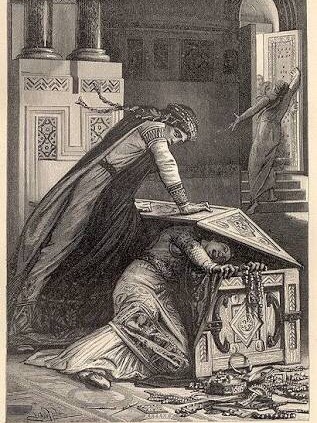medieval-women: Fredegund Queen Consort of Neustria (western Francia) Born ? - Died 597 CE Claim to
medieval-women: Fredegund Queen Consort of Neustria (western Francia) Born ? - Died 597 CE Claim to Fame: A brutal and formidable queen, best know for her forty year feud with her sister-in-law, Queen Brunhild of Austrasia. Background: High-ranking women in Merovingian Gaul could hold substantial wealth and status in the fifth and sixth centuries which enabled them to exercise significant social, political and religious influence. Born into a low-ranking family, Fredegund was a servant to the first wife of King Chilperic I of Neustria, Audovera. She seduced Chilperic and convinced him to divorce and expel Audovera. Chilperic then married a wealthy second wife, Galsuenda, but she soon died and was swiftly replaced as queen by Fredegund. Stories of Galsuenda’s death vary but it is believed that she spoke out against the immorality of Chilperic’s court so the King and his favourite mistress, Fredegund, had her strangled in bed. The powerful Queen Brunhild of Austrasia was both the sister-in-law of Chilperic (she was married to his brother) and the sister of Galsuenda. Brunhild’s fury at her sister’s death sparked a feud between the once unified houses of Austrasia and Neustria that spanned over forty years. The rivalry between Brunhild and Fredegund was particularly bitter and lead their families through generations of conflict. Fredegund is represented in primary sources as a particularly violent woman who used her desirability to manipulate and corrupt those around her. She frequently contracted assassins as well as torturing, maiming and killing opponents. Among her many alleged misdeeds, Fredegund was suspected of ordering the assassination of Brunhild’s husband, Sigebert I, and attempting to assassinate Brunhild’s son Childebert II, her brother-in-law Guntram of Burgundy, and even Brunhild herself. In a jealous rage, she even attempted to murder her own daughter, Rigunth, by slamming the lid of a chest down on her neck as she reached for the jewelry inside. However, her violence was not limited to royal family members, and included a number of officials, clergymen and locals. In a classic example, Fredegund attempted to quell a dispute between kinsmen but ‘when she failed to reconcile them with gentle words she tamed them on both sides with the ax’ by inviting them to a feast and having them all murdered. Her formidable reputation served her well and she manipulated all levels of society through the fear of her fury. When a dysentery epidemic struck her husband and two of her sons in 580 CE, Fredegund was plunged into remorse. Believing the epidemic was punishment for her sins, she burned unfair tax records and donated to the church and the poor after her sons succumbed to the disease. In 584 CE, her husband, Chilperic, was mysteriously assassinated and Fredegund sought refuge in the Notre Dame de Paris cathedral. She died of natural causes 8 December 597 in Paris and is entombed in Saint Denis Basilica. Several years after Fredegund’s death, her son Clothar II defeated Brunhild in battle and, despite the Queen being in her late sixties, he had her stretched on the rack for three days and then torn apart by four horses. Such was the bitterness of their familial enmity. Note: The main source for Fredegund’s life is Gregory of Tours’ History of the Franks. Gregory was patronised by Queen Brunhild so his depictions of her qualities and the evils of her rival, Fredegund, are likely biased. Other sources recognise Fredegund’s brutality but treat her and Brunhild more equitably. ~ Much of this mini-bio is based on an essay of mine, so please PM me for sources. -- source link
Tumblr Blog : medieval-women.tumblr.com
